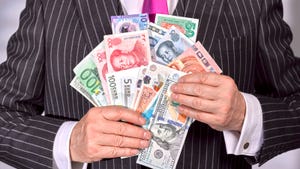Cross-Border M&A Activity on the Rise
Cross-border M&A can create tremendous opportunities for buyers to strengthen and grow their businesses, but it presents a unique set of challenges.
July 5, 2023

Michael Benson, Steven Simone, and Irune Andres
The landscape of global business has witnessed an active market for cross-border mergers and acquisitions (M&A). Hybrid activity in cross-border M&A has increased significantly relative to 2017/2018 levels: Hybrid acquirors now comprise approximately 40% of total cross-border deal volume in 2022 and the last 12 months as of March 2023.
Drivers of this activity reflect the evolving dynamics of the global economy and the strategic motivations of companies seeking to expand their presence and capabilities.
By offering a path to diversification and enhanced value-add, cross-border M&A can create opportunities for buyers to strengthen and grow their businesses.
Diversification and risk mitigation
Companies engage in cross-border M&A to diversify across geographic regions, reducing exposure to volatile economic and geopolitical events. The invasion of Ukraine by Russia and US/China tensions during the COVID-19 period prompted businesses to de-risk their operations and protect against such uncertainties.
End market diversification
Cross-border M&A enables companies to expand into new markets, diversify their customer base, and reduce dependence on a single market. This diversification strategy provides access to new growth opportunities and minimizes the impact of market-specific fluctuations. In addition, cross-border M&A enables entry into or further exposure to other process and product technology hot spots specific to certain geographies: Automation in Germany as well as capital equipment and broader industrial technology in Italy are two examples.
Unique perspective and value-add
In highly competitive M&A markets, buyers must differentiate themselves beyond offering the highest purchase price. For founder-owned businesses, preserving the brand, culture, and long-term growth prospects of the company are crucial. Buyers strive to offer a unique perspective or value-add, emphasizing their commitment to the company’s future success to set themselves apart from the broader pool of acquirors.
Expansion into low-cost markets
Many companies seek to expand into low-cost markets such as Mexico and Asia — particularly China and Southeast Asia — through cross-border M&A. Accessing these markets provides cost advantages and opportunities for operational efficiencies. Cross-border M&A also enables customers to pull suppliers into other geographies to localize their supply chain.
Advantages of cross-border M&A for both parties
The involvement of financial services company Stout in three recent acquisitions underscores the advantages of cross-border M&A.
Cross-border M&A empowers companies with global operations to establish a strong presence in new key markets, such as North America. The sale of Parkway Products to Clayens NP serves as an example: Parkway had established a multi-facility, North American platform through several ownership transitions. Their scale supported international expansion into Europe and Asia, and Clayens provided them with seamless entry into these markets with overlapping customers seeking additional geographic coverage from Parkway.
In similar cases, international buyers can establish North American headquarters in the United States, enabling them to provide a broader strategic perspective from their parent company abroad. This approach fosters continued growth for the American facilities while ensuring sufficient freedom and independence, avoiding a feeling of excessive micro-management at the American facilities.
Larger international strategic companies with substantial balance sheets often seek to hold investments for indefinite periods with an oversight style like financial sponsors, allowing management teams to operate rather independently. Polyfab found this balance with DAIHO, a Japan-based global corporation that was seeking to expand its footprint in the United States. DAIHO provided the founders of Polyfab with the autonomy to operate as if owned by a financial sponsor but with a longer-term horizon that supported continuous and stable operations.
In the sale of Plastic Components Inc. (PCI) to Rosti, PCI was solely operating in the US market but had customers urging them to expand into other geographic regions. The buyer in this case sought a US presence to complement its global exposure in various European and Asian geographies. PCI was focused on expanding its exposure to the medical sector, and its acquisition of SMI Molding provided an entry into this high-growth market. Rosti’s complementary customer and medical market expansion opportunities in Asia, a market that PCI recognized as having high growth potential, was a key differentiator for PCI when evaluating competing offers.
American companies and sellers recognize the value brought by international buyers who can facilitate access to foreign markets through existing or new customer relationships. This represents a significant growth lever for sellers, enabling them to provide their global customers with unique expertise, geographic reach, and value-added services.
Conducting M&A across borders introduces both advantages and obstacles into the dealmaking process.
Advantages of cross-border M&A
Cross-border M&A broadens the pool of potential buyers, increasing the chances of finding suitable partners for successful transactions. This broader buyer universe provides companies with incremental opportunities to identify compatible partners, facilitating smoother and more advantageous mergers or acquisitions. Additionally, international buyers will often pay a premium to secure “easier” access to specific geographies or footprints, enhancing the overall value of the acquired company.
Cross-border acquisitions can also provide immediate access to global customers, opening doors to higher organic growth potential and expanding the product portfolio and addressable market. Cross-border M&A enables companies to tap into a larger management and technical talent pool. This access to diverse skills and expertise facilitates innovation and enhances competitiveness.
Challenges of cross-border M&A
Cross-border transactions often involve additional complexities, however, such as language barriers and potential cultural differences. Thorough due diligence is required to navigate regulatory, legal, and tax considerations. Compliance with laws and regulations, such as the Foreign Corrupt Practices Act (FCPA), including review by bodies like the Committee on Foreign Investment in the United States (CFIUS), adds complexity to the process.
Additionally, negotiations in cross-border M&A may entail addressing different benchmarks and expectations across regions. These standards and requirements, such as facility cleanliness, employment terms, unions, pensions, and other factors, can complicate the dealmaking process.
Cross-border M&A fuels global business
Despite the challenges, the drivers and advantages of cross-border M&A continue to fuel globalization. Companies recognize the opportunities to expand their reach, tap into new markets, access talent, and enhance growth potential. By understanding these drivers and carefully navigating the challenges, businesses can strategically pursue cross-border M&A to achieve their global expansion objectives.
About the authors
|
Michael D. Benson |
Michael D. Benson is a managing director in Stout’s Investment Banking Group. He is responsible for the execution of investment banking transactions, which include mergers, acquisitions, divestitures, and the private placement of senior debt, subordinated debt, and equity securities.
Steven Simone |
Steven Simone is a vice president within the Investment Banking Group at Stout. His investment banking experience includes numerous M&A and corporate finance transactions, including buy- and sell-side assignments and leveraged buyouts. His experience also includes capital raising and strategic advisory assignments for sponsor-backed and entrepreneur-owned middle-market companies, as well as for multinational and publicly traded corporations.
|
Irune Andres |
Irune Andres is an associate in the Investment Banking Group at Stout. In this capacity, she focuses on merger and acquisition advisory, institutional private placements of debt and equity, and strategic consulting. Prior to joining Stout’s Investment Banking Group, Andres was a corporate finance summer analyst at Medline Industries, where she focused on financial planning and analysis.
Stout provides a full range of strategic alternatives including merger and acquisition (M&A) advice, private capital raising, financial sponsor coverage, and other financial advisory services to family-owned businesses, portfolio companies of private equity firms, and divisions of large corporations.
You May Also Like




